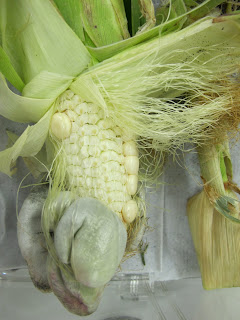Written by: Dr. Barbara Shew and Emma Lookabaugh
 |
| Sweet corn at the local farmers market (Photo by: H.D. Shew) |
On summer days, farmer’s markets are bursting with sweet corn. Shoppers buy ears by the dozens for good eating now and to stock their freezers for the winter. Corn – both field and sweet – is a relatively healthy crop and diseases usually do not trouble the home gardener. An exception is corn smut – it’s both common and easily recognized by its grotesque tumor-like galls and masses of dark sooty spores.
Recently, Dr. Mike Benson, a professor in our Department, brought in some smutted ears of sweet corn for class. The infected super sweet corn was his second planting during the first week of June. He noted that the fungus didn’t start showing up until the ears starting filling in during the first week of August and estimated that about 15% of his plants were infected in mid-August.
The corn smut fungus, Ustilago maydis, attacks corn (or maize; Zea mays) and its wild relatives (Zea spp.). It can infect all actively growing corn tissues, but the most obvious symptoms are tumor-like galls on the ears. Young galls are white and firm and are covered with a semi-glossy periderm, which eventually ruptures, exposing masses of sooty teliospores.
 |
| Young corn smut galls (Photo: H.D. Shew) |
The teliospores serve as overwintering inoculum for future corn crops. In the spring, teliospores are windblown or rain-splashed to nearby corn plants. The teliospores germinate to form sexual spores called basidiospores or sporidia. The sporidia can also be dispersed in wind or rain. Later, two sporidia fuse and give rise to the infective stage of the fungus.
Any above-ground plant part can be infected, including ears, tassels, silks, stalks, nodal shoots and leaf midribs. Distorted tissue may be noticeable within days after infection. Typically, galls form within a week and continue enlarging for up to three additional weeks. Initially, galls are composed primarily of host tissue undergoing tumor-like growth. As the galls age, their fleshy interior becomes streaked with black as dark sooty teliospores begin to replace the white host tissue. Eventually the gall becomes a mass of spores, dehydrates, and ruptures, releasing the teliospores.
 |
| Mature corn smut galls (Photo: H.D. Shew) |
Individual developing kernels are infected through the silks. Kernels are not susceptible to infection once pollination occurs, so any condition that reduces pollination favors smut infections. Drought stress (when pollen dies or tassels stop producing pollen) or extremely wet, humid weather (causing poor or no pollen production) opens up the window for infection. University of Illinois Professor Emeritus Jerald Pataky says that “wimpy males,” that is, plants that don’t produce pollen in adverse conditions or males (tassels) that are not ready when the females (ears) are ready for pollination, are more susceptible to smut.
 |
| Gall on single kernel (Photo: H.D. Shew) |
Smut usually makes sweet corn unmarketable due to cosmetic damage, but in parts of Mexico, it is actually prized. Traditional farmers gather young galls after natural infection and market them as Cuitlacoche (or Huitlacoche), a delicacy in Mexican cuisine. Often called the “Mexican truffle” or a “food of the gods,” it has been served up in Mexico since Aztec times. Nowadays, there is great interest in developing techniques for inoculating ears with smut and marketing the galls as gourmet fungi to upscale restaurants. It is a favorite ingredient in many soups, appetizers, and entrees because of its unique combination of earthy and corn flavors. Even here in Raleigh, NC, you can order up cuitlacoche and get a taste of this traditional Mexican delicacy.
 |
| Chicken breast stuffed with smut fungus (Photo: B.B. Shew, Jibarra Restaurant) |
In case you *don't* want smut in your corn, control options are limited. Rotation is somewhat helpful and it may help to remove and destroy (or eat!) smutted ears before the galls erupt. “Resistant” varieties are commonly recommended for control, but performance can be erratic since most are not truly resistant but instead escape infection. Choose varieties that are known to perform well in your region. Make several plantings during the spring. If all goes well, this will keep you in a steady supply of sweet corn for the summer. This also increases the chances that some of your plantings will escape major problems with poor pollination and smut.
References and links of interest:
 |
| Corn at the farmers market (Photo: H.D.Shew) |
References and links of interest:
Pataky, J. K., and K. M. Snetselaar. 2006. Common smut of corn. The Plant Health Instructor. DOI:10.1094/PHI-I-2006-0927-01
Jerald Pataky’s cuitlacoche recipes page http://www.sweetcorn.illinois.edu/Common-smut/Recipes.htm
In Mexico, Tar-Like Fungus Considered Delicacy
Mary Ann Hansen. Corn Smut. Virginia cooperative extension publication 450-706. http://pubs.ext.vt.edu/450/450-706/450-706.html
Special thanks to Dr. Pataky for help with this blog!
